EXCHANGE RATE REGIMES AND INFLATIONARY INSTABILITY IN SMALL AND OPEN ECONOMIES: FROM CRISIS TO ECONOMIC RECOVERY
DOI:
https://doi.org/10.46763/IJEMT2551111jKeywords:
еxchange rate regimes, Inflation, economic crisis, recoveryAbstract
This paper explores the relationship between exchange rate regimes and inflationary instability in small open economies, focusing on their role during periods of crisis and economic recovery. Small economies, due to their high degree of openness and limited monetary autonomy, are particularly vulnerable to external shocks and currency fluctuations. The choice of exchange rate regime—whether fixed, floating, or intermediate—plays a significant role in shaping inflationary trends and overall macroeconomic stability. Through an analysis of various regime types and their historical impact on developing countries, the paper highlights the importance of consistent and well-coordinated monetary and fiscal policies. Special attention is given to the challenges of maintaining price stability amid global uncertainty and the mechanisms through which exchange rate policy can either mitigate or amplify inflation. The findings emphasize that while no one-size-fits-all solution exists, flexible and credible exchange rate frameworks, combined with institutional resilience, are key to sustaining long-term economic recovery in small open economies.

